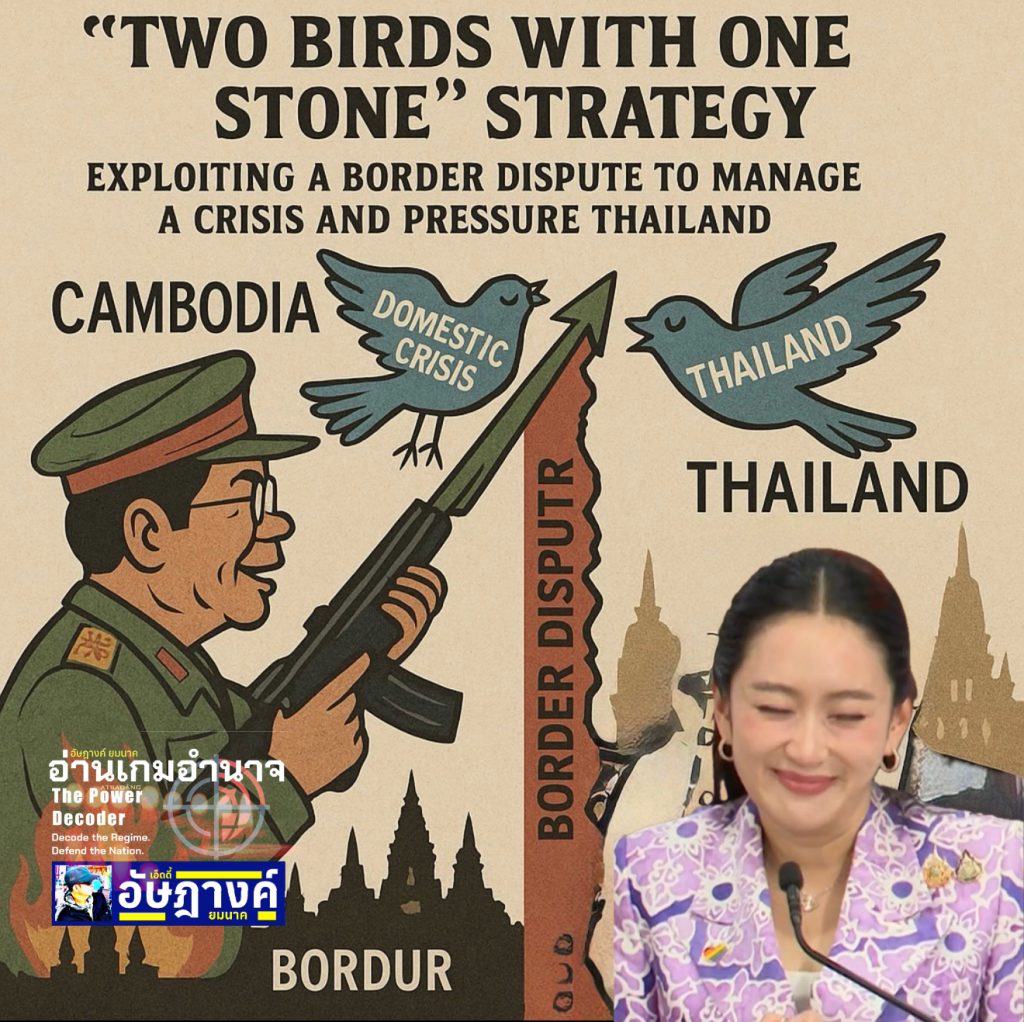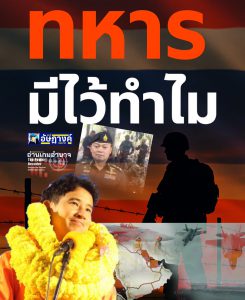
Cambodia’s “Two Birds with One Stone” Strategy
Border Disputes as a Tool for Domestic Crisis Management and Strategic Bargaining with Thailand
Policy Brief: Cambodia’s Calculated Provocations and Implications for Thai–ASEAN Stability
The Powe Decoder:
By Atsadang Yommanak
1. Strategic Overview
Under the long-standing leadership of Hun Sen and his successor Hun Manet, Cambodia has consistently engaged in calculated provocations along its border with Thailand. These actions are not sporadic but systematic and deliberate, falling within the framework of strategic provocation designed to serve two primary objectives:
• To divert domestic attention from economic hardship, political dissatisfaction, or social unrest by redirecting the public narrative toward external threats—namely, Thailand.
• To exploit tensions as diplomatic leverage, compelling Thailand to adopt more conciliatory stances in bilateral negotiations regarding security, economic projects, or regional cooperation.
2. The Mechanism of Calculated Provocations
Cambodia’s tactics may be broken down into a strategic sequence:
1. Fueling nationalist sentiment, using state media, films, or educational curricula to frame Thailand as an aggressor or cultural usurper.
2. Border encroachments, such as constructing infrastructure, deploying military personnel, or raising disputes at international forums.
3. Cultural symbolism offensives, claiming Thai heritage or proposing World Heritage listings in contested zones.
4. Triggering Thai responses, often calculated to paint Thailand as the aggressor should it react with force, damaging its diplomatic posture.
5. Using the manufactured tension as bargaining power, extracting concessions or cooperation in areas such as tourism, joint ventures, or trade access.
3. Risks to Thailand
• Diplomatic credibility erosion if Thailand miscalculates or appears aggressive.
• Escalation risk that could strain ASEAN mechanisms or undermine regional stability.
• Strategic exploitation by external powers, particularly China, which backs Cambodia and could manipulate the tension to pressure Thailand.
• Domestic discontent, especially if the Thai government is perceived as failing to safeguard national sovereignty.
4. Policy Recommendations
4.1 Short Term
• Establish a permanent bilateral crisis management team with Cambodia to prevent incursions and ensure direct communication.
• Disseminate culturally grounded narratives through Thai soft power to counter historical revisionism.
4.2 Medium Term
• Set up a risk communication strategy targeting regional media and public opinion.
• Fund independent think tanks specializing in Thai-Cambodian geopolitics and early warning systems.
4.3 Long Term
• Leverage ASEAN frameworks to codify mutually respectful border protocols.
• Promote subregional diplomacy with Laos and Vietnam to balance Cambodia’s growing alignment with China.
5. Strategic Conclusion
Cambodia’s provocations should not be seen as isolated incidents, but rather as components of a calculated statecraft by a regime facing internal vulnerabilities. Confronted with economic fragility and governance challenges, Phnom Penh turns to strategic confrontation to assert relevance.
Thailand must avoid reacting purely to surface-level provocations and instead adopt a structural, foresighted strategy to preserve national security, maintain diplomatic stature, and protect the integrity of ASEAN’s regional balance.
Cambodia’s behavior reflects a textbook example of calculated provocation by a secondary power applying Offensive Realist tactics in a constrained geopolitical context. By stoking nationalist sentiment and initiating low-level border tensions, Phnom Penh seeks to elevate its strategic relevance while leveraging its alliance with China—a classic case of Strategic Hedging as defined by Evelyn Goh (2007).
Meanwhile, its appeals to historical grievance and cultural ownership align closely with Symbolic Politics Theory, where emotion and identity override material capability as the basis for foreign policy behavior.
Thailand’s response, therefore, must be informed not only by immediate border defense imperatives but by long-term Soft Balancing strategies that sustain regional legitimacy while blunting provocations without escalation.
______________________________________________
กลยุทธ์ “ยิงปืนนัดเดียวได้นกสองตัว” ของเขมร

เกมก่อกวนโดยใช้ข้อพิพาทพรมแดนและเคลมวัฒนธรรมเพื่อบริหารวิกฤตภายในพร้อมทั้งใช้เป็นเครื่องต่อรองเพื่อผลประโยชน์ทางการทูตและความมั่นคงของตน
บทวิเคราะห์นโยบาย: กลยุทธ์ก่อกวนแบบมีแบบแผนของกัมพูชา และผลกระทบต่อเสถียรภาพไทย–อาเซียน
#อัษฎางค์ยมนาค #อ่านเกมอำนาจ
______________________________________________
1. ประเด็นยุทธศาสตร์
กัมพูชา ภายใต้การนำของฮุน เซน และสืบทอดโดยฮุน มาแนต ได้แสดงพฤติกรรมเชิงรุกบริเวณพรมแดนกับไทยในลักษณะที่เป็นระบบ สม่ำเสมอ และมีแบบแผน กลยุทธ์นี้สามารถจัดประเภทเป็น calculated provocation หรือ “การก่อกวนโดยเจตนาเพื่อหวังผลทางการเมือง” ซึ่งมีเป้าหมายหลัก 2 ประการ:
• เพื่อดึงความสนใจของประชาชนกัมพูชา ออกจากประเด็นเศรษฐกิจ/สังคมภายใน และหันเหไปสู่ภัยคุกคามจากภายนอก โดยเฉพาะไทย
• เพื่อใช้สถานการณ์ความตึงเครียดเป็น “เครื่องต่อรอง” ทางการทูตและความมั่นคง ทำให้ไทยต้องเลือกทางออกแบบประนีประนอม
______________________________________________
2. กลไกของกลยุทธ์ “ก่อกวนแบบมีแบบแผน”
พฤติกรรมของกัมพูชาสามารถจัดกระบวนการเชิงยุทธศาสตร์ได้เป็นลำดับดังนี้:
• ปลุกกระแสชาตินิยม ผ่านสื่อมวลชน ภาพยนตร์ หรือหลักสูตรประวัติศาสตร์ที่เสนอว่าไทย “ยึดครองดินแดน/วัฒนธรรมเขมร”
• ก่อกวนบริเวณพรมแดน เช่น การสร้างสิ่งปลูกสร้าง การขยับกำลังพล หรือการเปิดประเด็นในเวทีสากล
• รุกทางวัฒนธรรม/สัญลักษณ์ เช่น การเคลมมรดกไทยว่าเป็นเขมร หรือเสนอชื่อมรดกโลกในพื้นที่พิพาท
• เปิดช่องให้ไทยต้องตอบสนอง ซึ่งหากไทยตอบโต้ด้วยกำลัง จะถูกโจมตีว่า “รุกราน” และเสียพื้นที่ทางการทูต
• ใช้ความตึงเครียดเป็น leverage เพื่อเรียกร้องผลประโยชน์ทางเศรษฐกิจ/ความมั่นคง เช่น โครงการร่วมทุน การท่องเที่ยว หรือข้อตกลงชายแดน
______________________________________________
กรอบแนวคิดภูมิรัฐศาสตร์ของ“กลยุทธ์ก่อกวนแบบมีแบบแผนของกัมพูชา”
▍ Offensive Realism
(แนวคิดของ John J. Mearsheimer)
อธิบายว่ารัฐต่าง ๆ แสวงหาอำนาจมากขึ้นเรื่อย ๆ ไม่ใช่เพื่อความปลอดภัยเท่านั้น แต่เพื่อป้องกันไม่ให้รัฐอื่นขึ้นเป็นมหาอำนาจแทน ซึ่งสอดคล้องกับพฤติกรรมของกัมพูชาในการ “ท้าทาย” ไทยซึ่งเป็นประเทศที่มีเศรษฐกิจและอิทธิพลเหนือกว่าในภูมิภาค
อ้างอิง:
Mearsheimer, J. J. (2001). The Tragedy of Great Power Politics. W. W. Norton & Company.
______________________________________________
▍ Strategic Hedging
ประเทศขนาดเล็ก เช่น กัมพูชา ใช้กลยุทธ์ “การถ่วงดุลแบบมีไหวพริบ” โดยแสดงท่าทีแข็งกร้าวเฉพาะกับประเทศเพื่อนบ้าน (ไทย) ขณะเดียวกันก็ผูกสัมพันธ์แน่นแฟ้นกับมหาอำนาจ เช่น จีน เพื่อป้องกันตนเองในกรอบอำนาจใหญ่
อ้างอิง:
Goh, E. (2007). Great Powers and Hierarchical Order in Southeast Asia: Analyzing Regional Security Strategies. International Security, 32(3), 113–157.
Dent, C. M. (2010). China, Japan and Regional Leadership in East Asia. Edward Elgar.
______________________________________________
▍ Symbolic Politics Theory
การอ้างสิทธิ์ทางวัฒนธรรม เช่น การเคลมมรดกโลก หรืออัตลักษณ์ทางประวัติศาสตร์ เป็นเครื่องมือที่รัฐใช้ในการกระตุ้นอารมณ์ร่วมของประชาชน และสร้างความชอบธรรมในนโยบายต่างประเทศ แม้ไม่มีกำลังทางเศรษฐกิจหรือทหารเทียบเท่า
อ้างอิง:
Eidelson, R. J., & Eidelson, J. I. (2003). Dangerous Ideas: Five Beliefs That Propel Groups Toward Conflict. American Psychologist, 58(3), 182–192.
Kaufman, S. J. (2001). Modern Hatreds: The Symbolic Politics of Ethnic War. Cornell University Press.
______________________________________________
▍ Geostrategic Framing & Soft Balancing
ในบริบทของเอเชียตะวันออกเฉียงใต้ ประเทศอย่างไทยควรตอบสนองโดยไม่ใช้ความรุนแรงโดยตรง (Hard Power) แต่ใช้ “Soft Balancing” ผ่านกรอบอาเซียน, การสื่อสารสาธารณะ, และความร่วมมือทางเศรษฐกิจเพื่อจำกัดการเคลื่อนไหวของกัมพูชา
อ้างอิง:
Pape, R. A. (2005). Soft Balancing against the United States. International Security, 30(1), 7–45.
Acharya, A. (2009). Constructing a Security Community in Southeast Asia. Routledge.
______________________________________________
3. ความเสี่ยงต่อไทย
• บ่อนทำลายความน่าเชื่อถือทางระหว่างประเทศ หากไทยตอบโต้ผิดพลาดจะเสียภาพลักษณ์
• เสี่ยงต่อความขัดแย้งระดับภูมิภาค ที่อาจลุกลามเป็นข้อพิพาทในกรอบอาเซียน
• ถูกแทรกแซงจากมหาอำนาจ โดยเฉพาะจีนที่สนับสนุนกัมพูชา และอาจใช้สถานการณ์นี้กดดันไทยทางอ้อม
• ประชาชนไทยเกิดความไม่พอใจ ต่อการดูแลความมั่นคงพรมแดน อาจกระทบต่อความมั่นคงภายใน
______________________________________________
4. ข้อเสนอเชิงนโยบาย
4.1 ระยะสั้น
• ตั้งคณะทำงานร่วมไทย–กัมพูชาอย่างถาวร ที่เน้นการป้องกันเหตุล่วงล้ำและมีช่องทางสื่อสารฉุกเฉิน
• เผยแพร่ “ความจริงเชิงวัฒนธรรม” ผ่าน Soft Power
4.2 ระยะกลาง
• จัดตั้งกลไกสื่อสารความเสี่ยงชายแดนแบบ proactive เพื่อควบคุม framing ในสื่อไทยและอาเซียน
• สนับสนุน Think Tank ด้านภูมิรัฐศาสตร์ เพื่อเสนอข้อมูลวิเคราะห์ล่วงหน้าและแนวนโยบายเชิงลึก
4.3 ระยะยาว
• ใช้กรอบอาเซียนในการตั้งแนวปฏิบัติชายแดนที่ชัดเจนและเท่าเทียม
• บูรณาการความร่วมมือไทย–ลาว–เวียดนาม เพื่อลดแรงกดจากกัมพูชาที่ขยับเข้าหาจีน
______________________________________________
5. บทส่งท้าย
การวิเคราะห์กลยุทธ์ของกัมพูชาสะท้อนว่า ความตึงเครียดที่เกิดขึ้นไม่ใช่ความบังเอิญ แต่คือเครื่องมือเชิงยุทธศาสตร์ของรัฐที่อ่อนแอด้านเศรษฐกิจ สังคมและการเมือง แต่ใช้ความ แข็งกร้าวกลบเกลื่อน 

ไทยต้องพัฒนาความเข้าใจเชิงโครงสร้างและตอบสนองอย่างรอบคอบ เพื่อรักษาเสถียรภาพของตนโดยไม่ตกหลุมกลยุทธ์ของคู่แข่ง
______________________________________________



